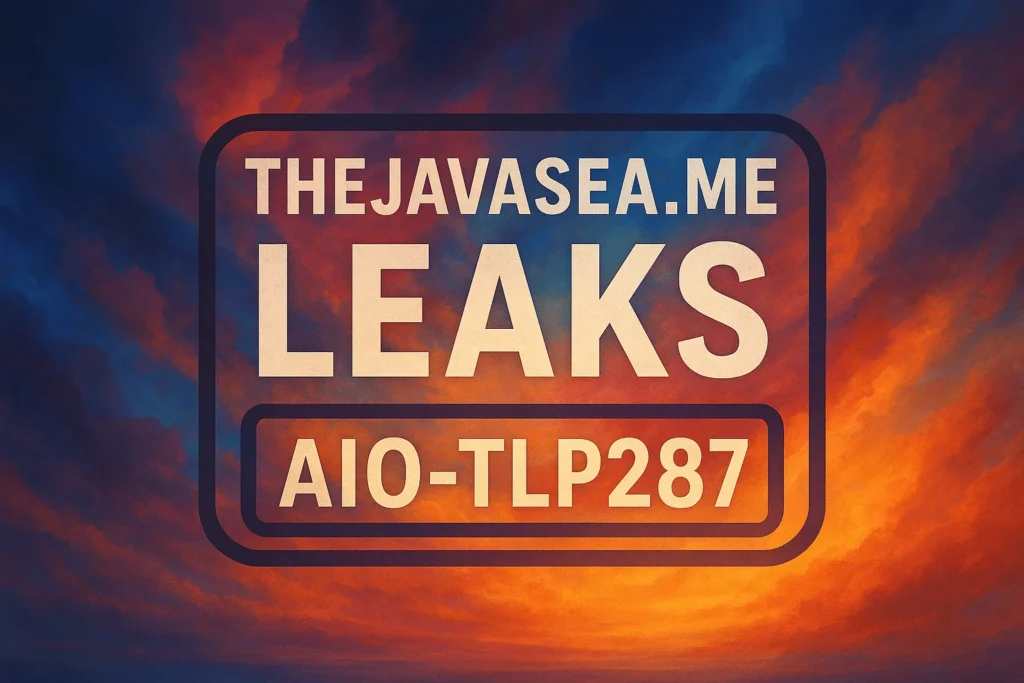Introduction
In today’s interconnected world, data security and privacy have become central concerns for individuals and organisations alike. Every day, massive amounts of information are shared across networks, forums, and digital platforms, creating opportunities but also vulnerabilities. One recent incident that has drawn attention is the javasea.me leaks aio-tlp exposure. This case highlights the risks involved when sensitive data is shared, leaked, or mishandled online. For those unfamiliar, the story revolves around a platform known as TheJavaSea.me and the leak of information categorised under the AIO-TLP framework. While the technical terms may seem overwhelming at first, unpacking them helps us understand the implications and lessons this incident carries for everyone navigating the digital space.
Understanding TheJavaSea.me
TheJavaSea.me is a digital platform that, like many others, provides resources, discussions, and sometimes sensitive materials to its users. Online communities often gather around such platforms to exchange information, whether for research, collaboration, or specialised interests. However, as with all community-driven sites, the sharing of data can occasionally move into grey areas where security becomes a critical concern.
When platforms operate with little oversight, they can unintentionally become hubs for distributing information that might not have been meant for public eyes. TheJavaSea.me has been mentioned in discussions tied to leaks, and the thejavasea.me leaks aio-tlp event demonstrates how such forums can be both a source of knowledge and a risk for participants.
What Are AIO-TLP Leaks?
To fully grasp the meaning of the incident, it is important to break down the terminology. (AIO) stands for (All-In-One), a concept often applied in digital spaces to collections or bundles of data that combine multiple resources in one package. Such compilations might include account information, research material, security tools, or databases that otherwise would be accessed separately.
On the other hand, (TLP) refers to the Traffic Light Protocol, a widely recognised system in the cybersecurity world that governs the sharing of sensitive information. TLP uses colour coding—such as TLP: RED, TLP: AMBER, TLP: GREEN, and TLP : WHITE—to define how widely information can be distributed. For example, TLP: RED is highly restricted, meant only for direct recipients, while TLP: WHITE can be freely shared.
When paired together in the phrase (thejavasea.me leaks aio-tlp,) it implies that bundles of sensitive data categorised under the TLP system were leaked through or associated with TheJavaSea.me. This raises alarms because it means that information meant to remain within trusted circles could have been exposed to wider, unintended audiences.
Key Information Exposed
While the specifics of the leaked content may vary, such leaks often involve valuable or sensitive data sets. These may include login credentials, personal identifiers, or security research findings. Even if the content appears harmless to the average person, within cybersecurity circles, such leaks can provide malicious actors with enough material to exploit systems or compromise privacy.
The troubling part about thejavasea.me leaks aio-tlp is that TLP-classified information is specifically intended to regulate exposure. When these safeguards fail, the trust that professionals, researchers, or community members place in the system collapses. It not only endangers individuals whose data is included in the leak but also undermines broader practices of information sharing across trusted networks.
Security and Privacy Concerns
Leaks like this bring to light multiple dimensions of risk. On a personal level, individuals whose credentials or identifiers are exposed may face threats such as identity theft, account takeovers, or phishing attacks. For organisations, such breaches can result in reputational damage, financial loss, and regulatory consequences.
In the broader cybersecurity ecosystem, thejavasea.me leaks aio-tlp also emphasises how fragile trust can be. Many security professionals rely on controlled information sharing to counter cyber threats and strengthen defences. If data leaks occur, participants may become hesitant to share findings, weakening the collective ability to respond to evolving risks.
Moreover, malicious actors are often quick to exploit leaked resources. Even seemingly minor data points can be pieced together to launch larger, more damaging attacks. That is why even partial leaks cannot be dismissed as insignificant—they represent puzzle pieces that adversaries may eagerly use.
Community and Industry Reactions
The online community surrounding such leaks often responds with a mix of concern, analysis, and debate. Some users may attempt to downplay the severity, suggesting that the leak contained little of value. Others highlight the risks, urging stricter controls and better safeguards in future exchanges.
In the case of thejavasea.me leaks aio-tlp, cybersecurity enthusiasts and professionals have underscored the importance of respecting TLP guidelines. Leaks like this serve as reminders that once information leaves its intended boundary, controlling its spread becomes impossible. Forums, researchers, and digital collectives must therefore balance openness with responsibility.
Industry observers have also noted that the rise of leaks tied to platforms like TheJavaSea.me illustrates a larger trend: the democratisation of information sharing. While openness has its advantages, it also requires vigilance and a recognition of how sensitive data can be weaponised if mishandled.
Lessons Learned from the Incident

The key lesson from thejavasea.me leaks aio-tlp is that security protocols, no matter how well-designed, only work if participants respect them. TLP was created to foster trust and clear communication about data sensitivity. But once a party disregards those rules, the entire framework is undermined.
Another lesson lies in the importance of proactive monitoring. Platforms that facilitate data exchanges must adopt stronger oversight, ensuring that sensitive bundles are not misused or redistributed. For individuals, the incident highlights the need for critical thinking before downloading, sharing, or storing material from online communities.
Finally, organisations must recognise that leaks are not just theoretical risks. They are real, recurring threats that demand ongoing investment in security infrastructure, staff training, and response planning.
How to Stay Protected
For individuals concerned about protecting themselves from the fallout of leaks like thejavasea.me leaks aio-tlp, several steps can make a difference:
- Use Strong, Unique Passwords: Reusing the same password across platforms creates vulnerabilities. A leak from one site could compromise multiple accounts.
- Enable Multi-Factor Authentication (MFA): Adding extra layers of verification greatly reduces the chance of unauthorised access.
- Monitor Accounts Regularly: Watching for unusual activity allows you to respond quickly if a breach occurs.
- Limit Data Sharing: Only provide information to platforms you trust, and avoid unnecessary oversharing.
For organisations, protecting against similar risks requires a stronger commitment:
- Enforce Data Classification Protocols: Ensure staff understand TLP and follow it rigorously.
- Invest in Security Monitoring: Use tools that detect unusual access or sharing of sensitive material.
- Educate Employees: Regular training ensures everyone understands how their actions affect security.
- Develop an Incident Response Plan: Being prepared reduces chaos when a leak happens.
The Bigger Picture
Beyond the immediate consequences, thejavasea.me leaks aio-tlp reflects the challenges of balancing open collaboration with data protection. As digital platforms grow, so too does the potential for leaks. The incident serves as a microcosm of the digital world: trust, security, and vigilance must coexist.
Cybersecurity experts argue that while no system is foolproof, building a culture of accountability and respect for protocols is critical. This includes individuals taking responsibility for their own security hygiene and organisations embedding safety into their operations.
Conclusion
The javasea.me leaks aio-tlp incident is a stark reminder that in the digital era, the boundary between secure and exposed information is thinner than ever. What may begin as a community exchange can quickly escalate into a serious breach when safeguards are ignored. By unpacking what happened, why it matters, and how to respond, we gain not just awareness but also actionable insight into staying safe.
Ultimately, the lesson is clear: vigilance, respect for protocols, and proactive measures are the keys to navigating an online world where leaks are not a question of if, but when.
READ MORE: selftimes


